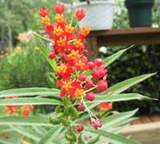Apocynaceae
Formerly Asclepiadaceae
Milkweed subfamily
This subgroup within the family Apocynaceae includes approxi- mately 240 genera of herbs, shrubs, and climbers, which are widely dis- tributed in tropical and temperate regions. leaves are simple, entire, often reduced, and opposite or whorled. This group lacks the char-acteristic salverform or funnel-shaped corolla of the traditional Apocynaceae genera. Flowers are hithly modified. The pollen grains are usually clumped in sticky masses called pollinia (orchids also have pollinia). Upon close inspec-tion, the flowers structures are quite marvelous, if not bizarre. The milky sap may be irritating to some people. milkweeds, familiar wildflowers of the United States, belong in this group. The fruits are paired pa-pery follicles. Silky tufts are at-tached to the seeds, which are easily carried away in the wind. Most species in this group attract monarch and viceroy butterflies.
Asclepias
Asclepias includes approximately 100 species of herbs, which are widely distributed in temperate and tropical regions. Flowers are rotate. The modified stamens and carpels are descriptively referred to as hoods and horns. Pollen grains are stuck together in clumps . Visiting insects depart with a knapsack of pollen rather than a meredusting. Glands can be found at the base of the leaf midvein. Asclepias curassavica is widely cultivated and has become naturalized in the eastern United States. It is a problem in pastures because it is poisonous to livestock. As a larval food, the species helps support the eastern population of monarch butterfies. This should not be surprising since the species is native to the winter territory of the threatened western population of monarchs. Asclepias physocarpa was once cultivated in Hawaii for possible commercial use of the silky fiber attached to its seeds and has become naturalized there. The fibers can be used as a downlike stuffing that is lighter than Ceiba kapok.
Asclepias curassavica
Mexican milkweed, Buttetfly weed, batal, flor de seda
 Tropical America, widely naturalized. Short – lived perennial herb to 2 ft, zones 8-11. Blooms warm months. Moderate moisture. Sandy, well- drained soil. full to part sun. Flowers: totate, fleshy, scarlet, selections orange and yellow or all yellow. Leaves: Lanceolate, to 4 in. long. A larval food of the monarch butterfly. Of woodlands, open fields, and coastal areas. but not salt tolerant. Poisonous to livestock. Grown as an annual in temperate regions.
Tropical America, widely naturalized. Short – lived perennial herb to 2 ft, zones 8-11. Blooms warm months. Moderate moisture. Sandy, well- drained soil. full to part sun. Flowers: totate, fleshy, scarlet, selections orange and yellow or all yellow. Leaves: Lanceolate, to 4 in. long. A larval food of the monarch butterfly. Of woodlands, open fields, and coastal areas. but not salt tolerant. Poisonous to livestock. Grown as an annual in temperate regions.
Asclepias physocarpa
Balloon cotton-bush, swan milkweed 
Synonym: Gomphocarpus physocarpus. Southeast Africa; widely naturalized. Shrubby perennial herb to 6 ft. +, zones 9-11. Blooms warm months. Moderate moisture. Sandy, well-drained soil. Full sun. Flowers: small, hoods white, capsule a pale green inflated sphere, covered with bristly hairs, to 3 in, diameter, seeds with silky tufts attached. leaves: Lanceolate – linear, 3-4 in.long. Coastal. The species name alludes to the “bladderlike fruit” a good field mark

Deprecated: strpos(): Passing null to parameter #1 ($haystack) of type string is deprecated in /home/agriviek8Qv/agriviet.net/public_html/wp-includes/comment-template.php on line 2522